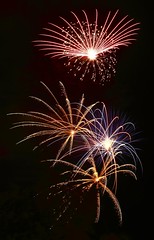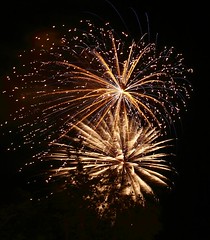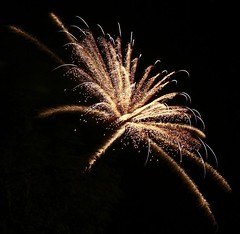 Every year around the 4th of July and New Year's Day, there are several people asking for advice on how to photograph the upcoming fireworks. It seems that the questions are almost always the same, just new people asking them.
Every year around the 4th of July and New Year's Day, there are several people asking for advice on how to photograph the upcoming fireworks. It seems that the questions are almost always the same, just new people asking them.I'll share my technique and offer some tips. If you're a seasoned photographer, then most, if not all, will be redundant. Other people should hopefully find this useful.
In some ways, this article is late by a couple of days; being written on July 5th. Or you can see the glass as half-full, and realize that you now have many months to get ready :-)
Quick Guide
Preparation
- Set your camera to ISO: 100, Aperture: f/11, Shutter Speed: Bulb
- Turn off Long Exposure NR (on my camera, it doubles the time for an exposure - essentially forcing a break between photographs)
- Put the camera on a tripod, with remote release cable attached
- Set the zoom on your lens to cover the desired area
- Set your lens to manual focus, and focus on infinity
The Fireworks
 As the fireworks go off, anticipate the bursts and shoot away. Take as many photographs as you can. You may end up throwing away a bunch of them.
As the fireworks go off, anticipate the bursts and shoot away. Take as many photographs as you can. You may end up throwing away a bunch of them.You can usually see the rocket go up before it explodes. Press the shutter as it's going up and keep it pressed till the sparks fall off.
The longer you keep the shutter pressed, the more fireworks you'll capture in that photograph.
Beyond that it's practice. Anticipating the bursts, capturing cool shapes, keeping the photos from being too busy, etc. comes from experience. The more you shoot, the better you'll get.
The Surroundings
Depending on where you are, you may have an interesting background that you want to show up with the fireworks.
To do this successfully, you need to think. Evaluate the background, judge how it's going to show up at the aperture you've chosen (f/11 in this case). Think about how long (shutter speed) you'll typically be shooting for. Adjust the aperture, consider using flash for some important features, etc. based on what you would like the final result to be. Use any and all the tricks in your bag.
In some cases, such as shooting a person in the foreground, the fireworks become less important and are just a background object. Even if they are slightly overexposed or underexposed, it is not a big problem. Shoot like you would shoot any other night portrait (beyond teaching here, but I may do another write-up later). Just keep in mind that your settings should allow for a shutter speed of at least a couple of seconds or so.
In other cases, the fireworks are the main subject and the other stuff is there to give a sense of place. For example, capturing the crowd watching the fireworks. A person's silhouette may be enough.

The photograph shown above was taken at 10 seconds. By keeping f/11, I could shoot for 20, 30 seconds without the background getting overexposed. However, if I shot at 2,3 seconds, the background would be underexposed.
My typical shutter speed (an after effect of the bulb exposure) is around 5-10 seconds.
Details
Some basics
- Firework start after sunset. This means that the setting around you is going to be dark. Keep this in mind if you want the surroundings to show up in the photograph (The Surroundings section in the Quick Guide)
- The fireworks themselves are very bright - they are exploding objects, after all.
- The best photographs of fireworks show trails. You are compressing time. In real life, or a video, you see an object go up, explode and the remnants fall off. You'll try to show this in one photograph.
Desired Equipment
I say desired as you may or may not have all the equipment I've listed. You may not be in a position to buy it either - because of money or time. That doesn't mean that you do not shoot at all. Experiment with what you have. I'll bet that at least a few (probably many) of your photographs come out great. Just skip over the explanation for equipment you don't have. Or read it for a justification to buy it.
- Camera with manual settings - ideally with a bulb exposure setting.
- Tripod
- Remote Release (cable or other mechanism)
- Lens hood

Now, I'll go over the equipment and how to use it. I'll give the information first, with each piece followed by an explanation of the why. This is based on my experience. Do feel free to tweak it as necessary as you gain experience. If something doesn't makes sense, or should be drastically different in your opinion, please do let me know.
Camera Settings
Assuming your camera has complete manual control, these are the setting you should use.
- ISO: 100
- Aperture: 11
- Shutter Speed: Bulb

Remember, the fireworks are very bright. The given combination of ISO and Aperture will allow you capture all the action in the sky, without overexposing the average firework burst. If you change one of the settings, you should tweak the other as well. If you don't you will end up with fireworks with no details in them, or conversely only the brightest fireworks showing up. The photograph on the right shows overexposed trails by shooting at ISO 800, f/10
Shutter Speed
The bulb setting on your camera will take a photograph as long as you keep the shutter button pressed. This means that you don't have to decide how long you want the exposure time to be before hand. You can decide for each burst of fireworks, as it is happening, how long that particular exposure is.
Equipment in more detail
Camera with Manual SettingsWithout manual settings, the camera is making critical choices for you. The fireworks will constantly be changing. By time it makes a decision, to when it takes the photograph, things may be very different. You are at the mercy of the camera's intelligence.
If you can set the values manually, then essentially, you are taking charge and bypassing the camera.
Tripod
You want to show the fireworks exploding, and making all kinds of cool shapes in the sky. That translates you to taking the photograph for a long time. I use the word "long" rather loosely, and all that means is that your exposure time is longer than what you can take hand-held. If the camera shakes in the slightest, you'll get zig-zaggy trails, like a child drew them (no offense to children with steady hands) instead of clean, sexy looking trails.

This photograph was taken hand-held; a 3 second exposure. You can see how the firework trails are squiggly.
If you don't have a tripod, you should put the camera on some other type of support. If you do decide to take hand-held photographs, keep the exposure time to a minimum... like 1/20th of a second or so (you may have to increase your ISO and decrease the Aperture# to get a good exposure).
This photograph was taken by putting the camera on the top of my car. You can read a quick write-up and see an uncropped photograph.

Remote Release
You've got the camera all set up on a steady support, and you are ready to take the photograph. If you press the shutter button with your finger, you'll shake the camera a little bit. The amount of shake will depend on so many things, such as how stable the support is, how sensitive the shutter button is, etc. If you're lucky, the shake won't be noticeable. According to Murphy's Law, it will be noticeable on your best photograph of the night.
The solution is to get a remote release cable. This cable hooks up to the camera, allowing you to take the photo without touching your camera.
Remote release cables are not too expensive, and for a Canon 40D cost about $40 for Canon and $13 for Opteka on Amazon.com. The prices fluctuate - I bought mine for $60 - but not too much.
Lens Hood
Depending on the location of street lamps, the road, etc. you may be located at a place where stray light can cause lens flare. Better safe than sorry, right?
And in the End
Good luck and keep shooting!!!Some photographs from the July 4, 2009 Fireworks in Central Park in San Ramon, California. Check out all the photographs from that show in my Flickr set, or browse the Fireworks collection.




I can't wait for firework night this year so I can try and get some good pictures. I didn't have an SLR last year so this will be my first attempts.
ReplyDeleteI don't think my camera has a bulb setting though what would I use instead?
Sharon, thanks for becoming a follower. It is flattering :-) I appreciate it.
ReplyDeleteI believe that all SLRs have a bulb settings. From your Flickr stream, I see that you have a 40D (same as I have).
Start increasing the shutter time, it goes to 30 seconds, and then to bulb. You will only see it Tv or M mode.
If you are using a different camera that doesn't have bulb, there a couple of different things you can do.
I would choose a time setting of 2-10 seconds for multiple streaks. In this case, you are taking a chance regarding the length of action. With multiple photographs, you will end up with a few good ones where the "action" fits in that time period well.
The other thing to do is to either get a piece of black paper, cardboard, etc. or just use your lens cap. You start the exposure, and as soon as you want to "end" the shot, you cover the lens. Even though technically, the shot is still being taken, nothing else will show up in the photograph.
Hope that answers your question.